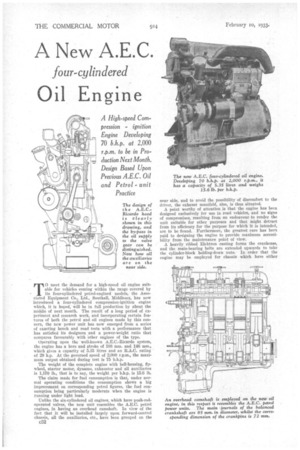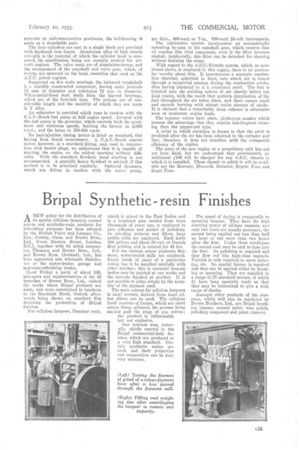A New A.E.C.
Page 102

Page 103

If you've noticed an error in this article please click here to report it so we can fix it.
four-cylindered
Oil Engine
T0 meet the demand for a high-speed oil engine suitable for vehicles coming within the range covered by its four-oylindered petrol-engined models, the Associated Equipment Co., Ltd., Southall, Middlesex, has now introduced a four-eylindered compression-ignition engine which, it is hoped, will be in full production by about the middle of next month. The result of a long period of experiment and research work, and incorporating certain features of both the petrol and oil engines made by this concern, the new power unit has now emerged from a series of exacting bench and road tests with a performance that has satisfied its designers and a power-weight ratio that compares favourably with Other engines of the type.
Operating upon the well-known A.E.C.-Ricardo system, the engine has a bore and stroke of 108 mm. and 146 mm., which gives a capacity of 5.35 litres and an R.A.C. rating of 29 h.p. At the governed speed of 2,000 r.p.m., the maximum output obtained during test is 75 b.h.p.
The weight of the complete engine with bell-housing, flywheel, starter motor, dynamo, exhauster and all auxiliaries is 1,170 lb., that is to say, the weight per b.h.p. is 15.6 lb.
The claim made for fuel consumption is that, under normal operating conditions the consumption shows a big improvement on corresponding petrol figures, the fuel consumption being particularly moderate when the engine is running under light load.
Unlike the six-cylindered oil engines, which have push-rodoperated valves, the new unit resembles the A.E.C. petrol engines' in having an overhead camshaft. In view of the fact that it will be installed largely upon forward-control chassis, all the auxiliaries, etc., have been grouped on the
separate or unit-construction gearboxes, the bell-housing is made as a detachable part.
The four cylinders are cast in a single block and provided with hardened iron liners. Aluminium alloy of high tensile strength is the material of which the cylinder head is composed, its specification being one recently evolved for aircraft engines. The valve seats are of aluminium-bronze and the arrangement of the camshaft and valve gear, which, of course, are mounted on the head, resembles that used on the A.E.C. petrol engines.
Supported on five main hearings, the balanced crankshaft is a sturdily constructed component, having main journals 85 mm. in diameter and crankpins 72 mm. in diameter. White-metal-lined steel shells form the big-end bearings, which are of the four-bolt type. The pistons are of considerable length and the material of which they are made is Y alloy.
An exhauster is provided which runs in tandem with the C.A.V.-Bosch fuel pump at half engine speed. Integral with the fuel pump is the governor, which controls both the maximum and minimum speeds, limiting the former to 2,000 r.p.m., and the latter to 350-400 r.p.m.
No fuel-injection timing device is fitted as standard, this having been found unnecessary. A C.A.V.-Bosch starter motor, however, is a standard fitting, and, used in conjunction with heater pings, we understand that it is capable of starting the engine on the coldest morning without difficulty. With the standard flywheel, hand starting is not recommended. A specially heavy flywheel is advised, if this method is to be practised regularly. Optional dynamos, which are driven in tandem with the water pump, are 61-in., 400-watt or 7-in., 800-watt 24-volt instruments.
The lubrication system incorporates an automatically operating • by-pass to the camshaft gear, which ensures that oil reaches this vital component, even if the filter becomes choked ; incidentally, this filter can be detached for cleaning without draining the sump.
With regard to the A.E.C.-Ricardo system, which, as mentioned above, is employed in this engine, there is no particular novelty about this. It incorporates a separate combustion chamber, spherical in form, into which air is forced through a tangential passage during the combustion stroke, thus having imparted to it a rotational swirl. The fuel is injected into the swirling sphere of air shortly before top dead centre, with the result that uniform distribution of 'the fuel throughout the air takes place, and there ensues rapid and smooth burning with almost entire absence of smoke. It is claimed that a remarkably clean exhaust is obtainable even at maximum engine loads.
The injector valves have plain, pintle-type nozzles which possess the advantage that they require less-frequeut cleaning than the pepper-pot type.
A point to which attention is drawn is that the swirl is produced after the air has been admitted to the cylinder and that, therefore, it does not interfere with the volumetric efficiency of the engine.
The price of the new engine as a proprietary unit has not yet been fixed, but we understand that provisionally an additional £100 will be charged for any A.E.C. chassis in which it is installed. Those chassis in which it will be available are the Mercury, Monarch. Matador, Regent Four and Regal Four.




































































































































































